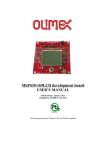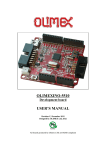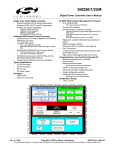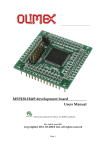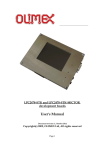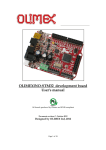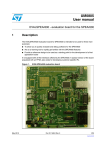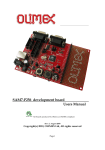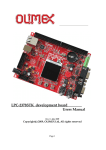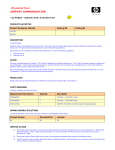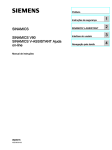Download MSP430-P2618 development board USER`S MANUAL
Transcript
MSP430-P2618 development board USER’S MANUAL Initial release, January 2013 Designed by OLIMEX Ltd, 2013 All boards produced by Olimex LTD are ROHS compliant OLIMEX© 2012 MSP430-P2618 user's manual Disclaimer © 2013 Olimex Ltd. Olimex®, logo and combinations thereof, are registered trademarks of Olimex Ltd. Other product names may be trademarks of others and the rights belong to their respective owners. The information in this document is provided in connection with Olimex products. No license, express or implied or otherwise, to any intellectual property right is granted by this document or in connection with the sale of Olimex products. The Hardware project is released under closed source terms. You will have to provide a link to the original creator of the project http://www.olimex.com on any documentation or website. You may also modify the files, but you must then release them as well under the same terms. Credit can be attributed through a link to the creator website: http://www.olimex.com The software is released under GPL. It is possible that the pictures in this manual differ from the latest revision of the board. The product described in this document is subject to continuous development and improvements. All particulars of the product and its use contained in this document are given by OLIMEX in good faith. However all warranties implied or expressed including but not limited to implied warranties of merchantability or fitness for purpose are excluded. This document is intended only to assist the reader in the use of the product. OLIMEX Ltd. shall not be liable for any loss or damage arising from the use of any information in this document or any error or omission in such information or any incorrect use of the product. This evaluation board/kit is intended for use for engineering development, demonstration, or evaluation purposes only and is not considered by OLIMEX to be a finished end-product fit for general consumer use. Persons handling the product must have electronics training and observe good engineering practice standards. As such, the goods being provided are not intended to be complete in terms of required design-, marketing-, and/or manufacturing-related protective considerations, including product safety and environmental measures typically found in end products that incorporate such semiconductor components or circuit boards. Olimex currently deals with a variety of customers for products, and therefore our arrangement with the user is not exclusive. Olimex assumes no liability for applications assistance, customer product design, software performance, or infringement of patents or services described herein. THERE IS NO WARRANTY FOR THE DESIGN MATERIALS AND THE COMPONENTS USED TO CREATE MS430-P2618. THEY ARE CONSIDERED SUITABLE ONLY FOR MSP430-P2618. Page 2 of 23 OLIMEX© 2012 MSP430-P2618 user's manual Table of Contents Disclaimer.....................................................................................................................2 CHAPTER 1 | OVERVIEW....................................................................................... 5 1.1 Introduction to the chapter.....................................................................................................5 1.2 Features.....................................................................................................................................5 1.3 Organization.............................................................................................................................5 CHAPTER 2 | SETTING UP THE MSP430-P2618 BOARD..................................7 2.1 Introduction to the chapter.....................................................................................................7 2.2 Electrostatic warning...............................................................................................................7 2.3 Requirements........................................................................................................................... 7 2.4 Powering the board..................................................................................................................8 2.5 Prebuilt software......................................................................................................................8 CHAPTER 3 | MSP430-P2618 BOARD DESCRIPTION....................................... 9 3.1 Introduction to the chapter.....................................................................................................9 3.2 Layout (top view).....................................................................................................................9 CHAPTER 4 | THE MSP430F2618 MICROCONTROLLER..............................10 4.1 Introduction to the chapter...................................................................................................10 4.2 The microcontroller...............................................................................................................10 CHAPTER 5 | CONTROL CIRCUITY...................................................................12 5.1 Introduction to the chapter...................................................................................................12 5.2 Reset........................................................................................................................................12 5.3 Clocks......................................................................................................................................12 CHAPTER 6 | HARDWARE....................................................................................13 6.1 Introduction to the chapter...................................................................................................13 6.2 JTAG connector.....................................................................................................................13 6.3 UEXT connector.................................................................................................................... 14 6.4 RS232 connector.................................................................................................................... 14 6.5 PWR jack................................................................................................................................15 6.6 Column pads (near the proto area)......................................................................................15 6.7 Battery connector...................................................................................................................16 6.8 Jumper description................................................................................................................17 6.9 Additional hardware components........................................................................................ 17 CHAPTER 7 | MEMORY AND BLOCK DIAGRAM...........................................18 7.1 Introduction to the chapter...................................................................................................18 7.2 Memory organization............................................................................................................ 19 CHAPTER 8 | SCHEMATICS.................................................................................20 Page 3 of 23 OLIMEX© 2012 MSP430-P2618 user's manual 8.1 Introduction to the chapter...................................................................................................20 8.2 Eagle schematic......................................................................................................................20 8.3 Dimensions..............................................................................................................................21 CHAPTER 9 | REVISION HISTORY.....................................................................22 9.1 Introduction to the chapter...................................................................................................22 9.2 Document revision................................................................................................................. 22 9.2 Board revision........................................................................................................................ 22 9.3 Web page of your device....................................................................................................... 23 Page 4 of 23 OLIMEX© 2012 MSP430-P2618 user's manual CHAPTER 1 | OVERVIEW 1.1 Introduction to the chapter Thank you for choosing the MSP430-P2618 development board from Olimex! This document provides a user’s guide for the Olimex MSP430-P2618 development board. As an overview, this chapter gives the scope of this document and lists the board’s features. The document’s organization is then detailed. The MSP430-P2618 development board enables code development of applications running on the MSP430F2618 microcontroller, manufactured by Texas Instruments. 1.2 Features ● ● ● ● ● ● ● ● ● ● ● ● ● ● ● ● ● MCU: MSP430F2618 with 116 KB + 256 B Flash Memory, 8 KB RAM JTAG connector RS232 driver + RS232 connector User button Power supply LED User status LED 32 768 Hz oscillator crystal Optional high frequency crystal (socket) RESET button External power supply jack for AC or DC power supply Voltage regulator + power supply filtering capacitor Extension headers for all uC pins Prototype area with 0.2'' step, Vcc + GND bus UEXT connector Connector for lithium polymer battery PCB: FR-4, 1.5 mm (0.062''), red soldermask Dimensions 99.38 x 79.31 mm (3.91 x 3.12") 1.3 Organization Each section in this document covers a separate topic, organized as follows: – Chapter 1 is an overview of the board usage and features Page 5 of 23 OLIMEX© 2012 MSP430-P2618 user's manual – – Chapter 2 provides a guide for quickly setting up the board Chapter 3 contains the general board diagram and layout – Chapter 4 describes the component that is the heart of the board: the MSP430F2618 microcontroller Chapter 5 is an explanation of the control circuitry associated with the microcontroller to reset. Also shows the clocks on the board – – – Chapter 6 covers the connector pinout, peripherals and jumper description Chapter 7 shows the processor diagram and memory map – – Chapter 8 provides the schematics Chapter 9 contains the revision history Page 6 of 23 OLIMEX© 2012 MSP430-P2618 user's manual CHAPTER 2 | SETTING UP THE MSP430-P2618 BOARD 2.1 Introduction to the chapter This section helps you set up the MSP430-P2618 development board for the first time. Please consider first the electrostatic warning to avoid damaging the board, then discover the hardware and software required to operate the board. The procedure to power up the board is given, and a description of the default board behavior is detailed. 2.2 Electrostatic warning MSP430-P2618 is shipped in a protective anti-static package. The board must not be exposed to high electrostatic potentials. A grounding strap or similar protective device should be worn when handling the board. Avoid touching the component pins or any other metallic element. 2.3 Requirements In order to set up the MSP430-P2618, the following items are required: - A source of power – the board can be powered through JTAG connector; or through the external power jack connector. - Debugger supporting 14 pin JTAG interface and the used microcontroller MSP430F2618. All our MSP430 programmers are recommended for MSP430-P2618: - Olimex MSP430-JTAG-TINY-V2 – small emulator/programmer ideal for beginners: https://www.olimex.com/Products/MSP430/JTAG/MSP430-JTAG-TINY-V2/ - Olimex MSP430-JTAG-ISO-MK2 – our best MSP430 emulator/programmer (featuring display, SD card and 3 modes of operation): https://www.olimex.com/Products/MSP430/JTAG/MSP430-JTAG-ISO-MK2/ - Olimex MSP430-JTAG-RF – the first wireless MSP430 emulator/programmer: https://www.olimex.com/Products/MSP430/JTAG/MSP430-JTAG-RF/ Also, a host-based software toolchain is required in order to program/debug the MSP430-P2618 board. There are also a number of ready IDEs available like IAR Embedded Workbench, Rowley CrossWorks, Code Composer Studio, etc. Page 7 of 23 OLIMEX© 2012 MSP430-P2618 user's manual We also provide our own flash programming software which can be distributed free. You can find it at the above mentioned debuggers' web pages. 2.4 Powering the board There are two options for powering the board: Either set the jumpers P_IN closed, P_OUT open so you can power from JTAG connector OR open P_IN, close P_OUT jumper and then use the power jack connecter to provide 5V DC. Note: In previous revisions there was an option to provide 6.5V AC, which is no longer the case. On powering the board the PWR LED, LED1 should turn on. 2.5 Prebuilt software On powering the board the PWR LED should turn on. The LCD should show 3 lines of text and the ability to control the selector marker between them. On pressing the joystick over our test of choice it should be conducted. Page 8 of 23 OLIMEX© 2012 MSP430-P2618 user's manual CHAPTER 3 | MSP430-P2618 BOARD DESCRIPTION 3.1 Introduction to the chapter Here you get acquainted with the main parts of the board. Note the names used on the board differ from the names used to describe them. For the actual names check the MSP430-P2618 board itself. 3.2 Layout (top view) Page 9 of 23 OLIMEX© 2012 MSP430-P2618 user's manual CHAPTER 4 | THE MSP430F2618 MICROCONTROLLER 4.1 Introduction to the chapter In this chapter is located the information about the heart of MSP430-P2618 – its microcontroller. The information is a modified version of the datasheet provided by its manufacturers. 4.2 The microcontroller Features: ● Low Supply Voltage Range, 1.8 V to 3.6 V ● Ultra-Low Power Consumption: - Active Mode: 365 µA at 1 MHz, 2.2 V - Standby Mode: 0.5 µA - Off Mode (RAM Retention): 0.1 µA ● Wake-Up From Standby Mode in Less Than 1µs ● 16-Bit RISC Architecture, 62.5-ns Instruction Cycle Time ● Three-Channel Internal DMA ● 12-Bit Analog-to-Digital (A/D) Converter With Internal Reference, Sample-and-Hold, and Autoscan Feature ● Dual 12-Bit Digital-to-Analog (D/A) Converters With Synchronization ● 16-Bit Timer_A With Three Capture/Compare Registers ● 16-Bit Timer_B With Seven Capture/Compare-With-Shadow Registers ● On-Chip Comparator ● Four Universal Serial Communication Interfaces (USCIs) - USCI_A0 and USCI_A1 - Enhanced UART Supporting Auto-Baudrate Detection - IrDA Encoder and Decoder - Synchronous SPI - USCI_B0 and USCI_B1 - I2C - Synchronous SPI ● Supply Voltage Supervisor/Monitor With Programmable Level Detection ● Brownout Detector ● Bootstrap Loader Page 10 of 23 OLIMEX© 2012 MSP430-P2618 user's manual ● Serial Onboard Programming, No External Programming Voltage Needed Programmable Code Protection by Security Fuse ● 116KB+256B Flash Memory, 8KB RAM 1 For comprehensive information on the microcontroller visit the Texas Instruments web page for a datasheet. At the moment of writing the microcontroller datasheet can be found at the following link: http://www.ti.com/lit/ds/symlink/msp430f2618.pdf Page 11 of 23 OLIMEX© 2012 MSP430-P2618 user's manual CHAPTER 5 | CONTROL CIRCUITY 5.1 Introduction to the chapter Here you can find information about reset circuit, power circuit and quartz crystal locations. 5.2 Reset MSP430-P2618 reset circuit features a capacitor C36(47n) and processor pin 58(RST/NMI). You could also reset the MCU with an active low level at the JTAG pin 11. 5.3 Clocks Real time clock (RTC) 32 768Hz Q1 is connected to pins 8 and 9 of the processor. A free socket for custom quartz crystal Q2 is connected to pins 52 and 53 of the processor. Page 12 of 23 OLIMEX© 2012 MSP430-P2618 user's manual CHAPTER 6 | HARDWARE 6.1 Introduction to the chapter In this chapter are presented the connectors that can be found on the board all together with their pinout. Proto area is shown. Jumpers functions are described. Notes and info on specific peripherals are presented. Notes regarding the interfaces are given. 6.2 JTAG connector The 14 pin JTAG connector provides the interface for JTAG programming/debugging. The plastic connector is situated at the bottom of the board. The pinout can be found in the table below. JTAG Connector Pin # Signal Name Pin # Signal Name 1 TDO 8 Not connected 2 P_IN/NC* 9 GND 3 TDI 10 Not connected 4 NC/P_OUT* 11 #RST 5 TMS 12 Not connected 6 Not connected 13 Not connected 7 TCK 14 Not connected *Depending on the jumper P_OUT/P_IN position Page 13 of 23 OLIMEX© 2012 MSP430-P2618 user's manual 6.3 UEXT connector UEXT is used to connect expansion modules made by Olimex. It features SPI, UART and I2C (when all three are available at the microcontroller) UEXT Connector Pin # Signal Name 1 +3.3V 2 GND 3 UTXD1 4 URXD1 5 SCL1 6 SDA 7 SOMI1 8 SIMO1 9 UCLK1 10 STE1 6.4 RS232 connector RS232 Pin # Signal Name 1 NC 2 T2OUT 3 R1IN 4 NC 5 GND 6 NC 7 NC 8 NC Page 14 of 23 OLIMEX© 2012 9 MSP430-P2618 user's manual NC T2OUT - Output Transmit Data. This is the transmit data line for the RS232 interface. R1IN - Input Receive Data. This is the receive data line for the RS232 interface. 6.5 PWR jack Note that the board should be powered by only 5V DC. PWR jack Pin # Signal Name 1 PWR 11 GND 6.6 Column pads (near the proto area) Important: the top row of the proto area is 3.3V; the bottom row is GND. Be careful with shortcircuit! The pads have their names printed on the board. Pin # Signal Name Pin # Signal Name 1 VCC 2 GND 3 P6.6 4 P6.7 5 P6.4 6 P6.5 7 P6.2 8 P6.3 9 P6.0 10 P6.1 11 VCC 12 GND 13 P5.6 14 P5.7 15 P5.4 16 P5.5 17 P5.2 18 P5.3 Page 15 of 23 OLIMEX© 2012 MSP430-P2618 user's manual 19 P5.0 20 P5.1 21 VCC 22 GND 23 P4.6 24 P4.7 25 P4.4 26 P4.5 27 P4.2 28 P4.3 29 P4.0 30 P4.1 31 VCC 32 GND 33 P3.6 34 P3.7 35 P3.4/TXD0 36 P3.5/RXD0 37 P3.2 38 P3.3 39 P3.0 40 P3.1 41 VCC 42 GND 43 P2.6 44 P2.7 45 P2.4 46 P2.5 47 P2.2 48 P2.3 49 P2.0 50 P2.1 51 VCC 52 GND 53 P1.6 54 P1.7 55 P1.4 56 P1.5 57 P1.2 58 P1.3 59 P1.0 60 P1.1 6.7 Battery connector When using the battery connector keep in mind that it is an energy solution that wouldn't be able to power the board and all the peripherals. The voltage of a 3.7V LIPO battery would be enough to power the processor and the memory but won't be enough to power external touchscreen LCD. Pin # Signal Name 1 VIN 2 GND Page 16 of 23 OLIMEX© 2012 MSP430-P2618 user's manual 6.8 Jumper description P_OUT/P_IN - This jumper controls power on pins 2 and 4 of the JTAG connector. When in P_OUT is closed 3.3V can be measured at pin 4. Check the schematic for more info. Default position is P_OUT – closed, P_IN - open. 6.9 Additional hardware components The components below are mounted on MSP430-P2618 but are not discussed above. They are listed here for completeness: User button with name BUT connected to MSP430F2618 pin 60 (P6.1/A1). Reset button with name RST connected to MSP430F2618 pin 58 (RST/NMI). Power LED with name PWR – lights when the board is power supplied. Status red LED with name LED connected to MSP430F2618 pin 59 (P6.0/A0). Page 17 of 23 OLIMEX© 2012 MSP430-P2618 user's manual CHAPTER 7 | MEMORY AND BLOCK DIAGRAM 7.1 Introduction to the chapter At the right side of the page is located the block diagram of the processor and on the next page you can find a memory map for this family of processors. It is strongly recommended to refer to the original datasheet released by Texas Instruments for ones of higher quality. Page 18 of 23 OLIMEX© 2012 MSP430-P2618 user's manual 7.2 Memory organization Page 19 of 23 OLIMEX© 2012 MSP430-P2618 user's manual CHAPTER 8 | SCHEMATICS 8.1 Introduction to the chapter In this chapter is located the schematic describing logically MSP430-P2618. 8.2 Eagle schematic 3.3V U1 C3 C2 10uF/6.3V 100n 10uF/6.3V 0R C7 NA P2.0/ACLK P2.1/TACLK P2.2/CAOUT P2.3/CA0 P2.4/CA1 P2.5/ROSC P2.6/ADCLK P2.7/TA0 P3.0/STE0 P3.1/SIMO0 P3.2/SOMI0 P3.3/ULCK0 P3.4/UTXD0 P3.5/URXD0 P3.6/UTXD1 P3.7/URXD1 Q2 NA Q1 32768Hz C4 C5 8 9 C8 20pF C9 20pF RST JTAG 1 2 3.3V HN1x2 1 2 P_OUT HN1x2 14 12 10 8 6 4 2 XT2IN XT2OUT P4.0/TB0 P4.1/TB1 P4.2/TB2 P4.3/TB3 P4.4/TB4 P4.5/TB5 P4.6/TB6 P4.7/TBCLK TCK TDI TDO/TDI TMS P5.0/STE1 P5.1/SIMO1 P5.2/SOMI1 P5.3/UCLK1 P5.4/MCLK P5.5/SMCLK P5.6/ACLK P5.7/TH 10pF 10pF 13 11 9 7 5 3 1 Q3 53 52 57 55 54 56 XIN XOUT/TCLK P_IN V+ 3.3V R6 V+ 0R R10 3.3V 0R P6.0/A0 P6.1/A1 P6.2/A2 P6.3/A3 P6.4/A4 P6.5/A5 P6.6/A6 P6.7/A7 C14 100n 64 62 C13 1 63 100n AVCC AVSS DVCC DVSS P2.0 P2.1 P2.2 P2.3 P2.4 P2.5 P2.6 P2.7 28 29 30 31 32 33 34 35 PWR_RS SDA_1XX/SDA_2XX SCL_2XX SCL_1XX TXD0 RXD0 UTXD1 URXD1 36 37 38 39 40 41 42 43 P3.0 P3.1 P3.2 P3.3 P3.4 P3.5 P3.6 P3.7 P4.0 P4.1 P4.2 P4.3 P4.4 P4.5 P4.6 P4.7 44 45 46 47 48 49 50 51 STE1 SIMO1 SOMI1 UCLK1 59 60 61 2 3 4 5 6 LED BUT P5.0 P5.1 P5.2 P5.3 P5.4 P5.5 P5.6 P5.7 P6.0 P6.1 P6.2 P6.3 P6.4 P6.5 P6.6 P6.7 3.3V 20 21 22 23 24 25 26 27 LED & BUT 3.3V_1 GND_1 3.3V 3.3V R2 100k LED LED_GREEN_0603 R4 B1 3.3V_2 GND_2 R12 2k B UT 330R BUT LED 3.3V_3 GND_3 UEXT 3V3 3.3V_4 GND_4 SCL_1XX 3V3 R7 100k 3.3V_5 GND_5 SCL_2XX 3V3 R8 100k 3V3 R9 100k UTXD1 URXD1 SCL SDA_1XX/SDA_2XX 1 VREF+ R13 VEREF+ VREF+ VREF- P1.0 P1.1 P1.2 P1.3 P1.4 P1.5 P1.6 P1.7 2 SOMI1 3 10 7 11 12 13 14 15 16 17 18 19 3.3V NA R11 P1.0/TACLK P1.1/TA0 P1.2/TA1 P1.3/TA2 P1.4/SMCLK P1.5/TA0 P1.6/TA1 P1.7/TA2 NA(1nF) 3.3V 0R R3 C18 RST/NMI 3.3V 58 3.3V RST SCL_2XX/SCL_1XX R14 47k RST R1 3.3V V+ V+ MSP430-P2618 schematic is visible for reference here. You can also find it with higher quality on the web page for MSP430-P2618 at our site: https://www.olimex.com/Products/MSP430/Starter/MSP430-P2618/. It is located in HARDWARE section. SIMO1 UCLK1 STE1 UEXT-1 UEXT-2 UEXT-3 UEXT-4 UEXT-5 UEXT-6 UEXT-7 UEXT-8 UEXT-9 UEXT-10 BH10S BH10S BH10S BH10S BH10S BH10S BH10S BH10S BH10S BH10S 3.3V_6 GND_6 MSP430F2618 POWER_SUPPLY PWR_J VR1(3.3V) M CP1700T -3302E/MB TXD0 4 C2+ 5 C2- 11 10 RXD0 12 9 T1IN T2IN R1OUT R2OUT V- 6 C1 100n C6 100n R5 22R U2PWR 15GND RS232 T1OUT T2OUT R1IN R2IN 14 7 13 8 1 2 3 4 5 16 VCC 3 C12 100n V+ C1- 2 2 1 3 C1+ 6 7 8 9 C10 100n PWR_RS 3.3V/PWR_RS 1 GND 3.3V ST3232CD Page 20 of 23 R15 2k + 1 2 3.7V-LI_B AT DW02R - 10uF/6.3V PWR U2 C11 100n 1 MSP430-P2618_rev_D OLIMEX LTD, BULGARIA https://www.olimex.com 3.3V VIN VOUT 3 GND C15 C17 2 1 RS232 BAT54C D1 CLOSE 5VDC PWR_LED_E 2 100n GND_7 C16 10uF/6.3V OLIMEX© 2012 MSP430-P2618 user's manual 8.3 Dimensions Note that the dimensions of the board are in mils. Page 21 of 23 OLIMEX© 2012 MSP430-P2618 user's manual CHAPTER 9 | REVISION HISTORY 9.1 Introduction to the chapter In this chapter you will find the current and the previous version of the document you are reading. Also the web-page for your device is listed. Be sure to check it after a purchase for the latest available updates and examples. 9.2 Document revision Revision Changes Modified Pages C Initial release All D Recreated document All 9.2 Board revision Revision D Changes UEXT added Lithium battery connector added Lowered PROTO area size Removed AC rectifier LM1117 changed with a lower power 3.3V regulator Optimized the schematic for lower power Page 22 of 23 OLIMEX© 2012 MSP430-P2618 user's manual 9.3 Web page of your device The web page you can visit for more info on your device is https://www.olimex.com/Products/MSP430/Proto/MSP430-P2618/. There you can find more info and some examples. ORDER CODES: MSP430-P2618 - completely assembled and tested MSP430-JTAG-TINY-V2 – mini emulator/programmer USB<->JTAG 14p MSP430-JTAG-ISO-MK2 – our best MSP430 emulator/debugger with extra features MSP430-JTAG-RF – wireless emulator/programmer USB<->JTAG 14p How to order? You can order directly from our web shop or from any of our distributors. Check our webpage https://www.olimex.com/ for more info. For the full list of distributors visit https://www.olimex.com/Distributors/. Page 23 of 23























